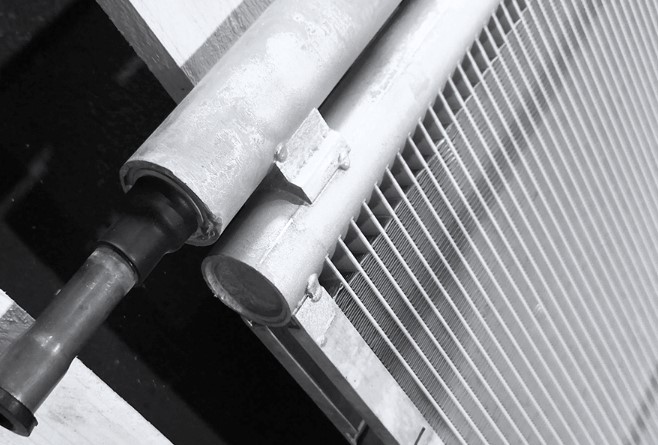Gas prices add to business cost burdens | Business News

Sign of the times
Rising gasoline prices are hitting consumers in the pocketbook, and no relief appears to be in sight.
A complex variety of factors rules the global market for oil, which determines the price of gasoline.
But at the outset of the summer season, Colorado tourism officials are not expecting people to stop traveling — they’re just going to be doing it differently this year.
Businesses, too, are feeling the effects of higher gas prices.
Those that consume the most fuel — the trucking trucking industry, for example — are the most directly affected, but gas price spikes trickle down to other businesses in the form of higher costs.
Even though gas prices have risen more than a dollar a gallon since this time last year, some small business owners say they’ve had other cost increases that were more troubling — and that gas prices are just another few drops in the bucket.
Christian Patriarca, who co-owns Slice 420 Pizza with his wife Stefany, said the companies from which he buys supplies have added fuel surcharges, but they’re small in relation to the cost of chicken — what used to be a $50 order now costs him $220.
For now, business owners like Patriarca and Becky Elder, owner of Becky Elder the Gardener, have not increased delivery charges but say they may have to if the surge in gas prices continues.
While most businesses are having to compensate for higher fuel prices, a few businesses are benefiting from the gas price rise — buyers are showing increased interest in hybrid and electric vehicles.
SUPPLY AND DEMAND
According to AAA Colorado, the price of a gallon of regular gas as of May 31 averaged $4.257 in Colorado Springs — an increase of 29 cents since last month ($3.971). A year ago, a gallon of regular gas cost an average of $3,097, or $1.16 lower than the current average.
Colorado Springs’ gas prices on May 31 were a bit better than the state as a whole, which averaged $4.278 per gallon, and were below the national average of $4.622.
Midgrade fuel averaged $4.602 per gallon on May 31 in Colorado Springs, and premium and diesel gas prices soared even higher, to $4.902 and $5.320, respectively.
The cost of gas is determined by a variety of factors that influence demand and supply, said Skyler McKinley, regional director, public affairs for AAA Colorado.
“Heading into 2022, the petroleum market was already squeezed tight,” McKinley said. “The reason for that is that as COVID-19 hit the world, a lot of oil and gas production shuttered because there wasn’t much demand. Demand came roaring back in the post vaccine world when folks were commuting back to their offices, when they were getting on cruise ships, when they were getting on airplanes.”
Demand returned much more quickly than supply, McKinley said.
“The OPEC countries were not meeting their production targets,” he said. “U.S. production did not return, and still has not returned.”
The tight market stiffened even more when Russia invaded Ukraine on Feb. 24, he said.
“Russia accounts for about 12 percent of all global energy exports,” McKinley said. “We only use about 3 percent of Russian oil in the United States, but it’s a global market, and taking Russian oil out of the equation created additional shocks on the supply side.”
Cassie Tanner, deputy director of public affairs at AAA Colorado, noted that crude oil prices are hovering around $110 a barrel and pointed out that every year, gas prices jump just before Memorial Day and traditionally remain high during the summer, when demand increases.
“The switch to the more expensive summer blend of gasoline, which usually adds 7-10 cents per gallon, is happening now,” Tanner said. “That switchover should be completed nationwide by early June.”
McKinley said AAA is starting to see data that indicates a softening in demand because of the high cost.
“That could stabilize prices,” he said. “But I still suspect we’re going to see gradual increases throughout the summer.”
McKinley said he doesn’t expect to see major price spikes this summer, but that could change if a severe hurricane season causes domestic production and refining to suffer.
But he also doesn’t foresee prices to fall much until after Labor Day, “unless for some reason there is a flood of new production entering the market, and there’s not really an economic incentive for producers to produce oil right now.”
That’s because oil companies took big losses during the early days of the pandemic and are looking to make up some of those losses, he said.
“Right now, they’re getting much more profit per barrel of oil by keeping supply limited,” he said. “There’s talk within leadership with the oil companies that they’re not going to jump back into the market, because it is very profitable right now, and there’s a lot of uncertainty about how long demand will stay up.”
The high cost of diesel fuel is greatly impacting the trucking industry, McKinley said.
“We’re going to see rising costs because it’s just costing a lot more to ship things,” he said. “Everybody to some extent is going to have to pay the piper.”
TOURISTS TIGHTEN BELTS
As the summer tourism season opens, McKinley said travel interest remains strong.
“We might lose some out-of-state travelers, but some in state might be cutting costs by staying closer to home,” he said.
For example, people in the Denver metro area might come to Colorado Springs rather than planning a trip to Yellowstone.
However, demand for flights to Colorado Springs is strong, said Doug Price, president and CEO of Visit Colorado Springs.
“According to the most recent research we’ve seen from Tourism Economics, 80 percent of people in this country are ready to travel and 90 percent plan to travel in the next six months,” Price said. “The airlines are reporting that ticket sales are going through the roof. That’s why I am optimistic, overall, about the summer.”
Whether they fly or drive, visitors will be looking to spend less in other ways to make up for higher fuel prices.
“They’ll look to save money on lodging, meals and attractions,” Price said. “I think the one decrease we’re going to see is in RV travel because of gas prices.”
He said Visit COS for the first time has posted a page on its website that highlights low-cost activities like walking tours and sightseeing in Old Colorado City and Manitou Springs, and affordable attractions such as Miramont Castle in Manitou Springs, the Space Foundation Discovery Center and the Ghost Town Museum.
“Once you get here, if you stay downtown, you can walk to a lot of things, or you can take PikeRide or a scooter or Mountain Metro to get around,” Price said. “We’re trying to help people who are a little bit more budget-minded than maybe they would have been a couple of months ago.”
Colorado Springs is a regional drive destination, Price said, but Visit COS also is advertising in six markets located farther away. They include Atlanta, Chicago, Phoenix, Dallas, Houston and Washington, D.C. The Colorado Springs Airport offers nonstop service to and from the first five markets, and one-stop service for the nation’s capital.
Price said he thinks a bigger wild card for the summer tourist season is COVID.
“What I’m most concerned about is COVID coming back — the things we really can’t control,” he said. “We’re watching that very carefully.”
ALL COSTS INCREASING
Local businesses like Patriarca’s Slice 420 Pizza have been hamstrung by rising costs for the past two years.
“A lot of our costs have dramatically increased way before the last six months,” he said, adding that he’s paying more for flour and items like pepperoni.
Patriarca uses his own employees for delivery, and while they have to buy their own gas, drivers are paid $3 more per hour than the minimum wage for restaurant employees.
“That should help them compensate,” he said.
Big suppliers have already added delivery surcharges, but Slice 420 has not increased its delivery charge, which is $3.50, he said. But he added he might have to increase the charge if gas prices keep climbing.
“At the end of the day, we can afford that extra dollar [per gallon] because we’re Americans and we go to work and do what we need to do,” he said.
Elder said she does a lot of driving in her landscaping business, including picking up and delivering supplies.
Elder hires independent contractors to help with garden planting and maintenance.
“We try to encourage carpooling,” she said. “If they have to drive a long way, I pay them for half the drive.”
Elder said she may end up putting a small surcharge on client invoices — “something reasonable, like $5-10, depending on the drive. That gives some buffer so that you can give gas money to your gardeners if you need to.”
Personally, she said, her gas expenses have doubled, and she is looking to trade in her gas-powered vehicle for a Prius.
Elder apparently isn’t the only business owner thinking that way.
Peter Buckles, general manager and partner of Phil Long EVOutlet and Phil Long Kia, said the dealership is seeing increased interest in electric or hybrid cars and SUVs.
“The Phil Long EV Outlet opened in May 2021, and monthly sales have doubled in electrical vehicle sales from last year,” Buckles said.
However, “we have not seen a negative impact in sales volume of gas-powered vehicles; actually it’s the exact opposite,” he said. “We have seen many more people shopping for vehicles — all kinds not just the good gas mileage ones. Phil Long Kia is up 92 percent year-over-year in used car sales, and we don’t see it slowing down.”









